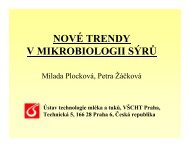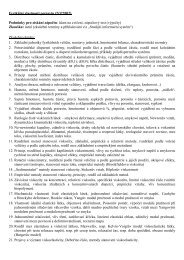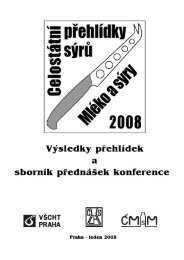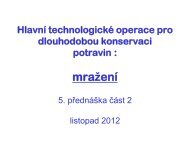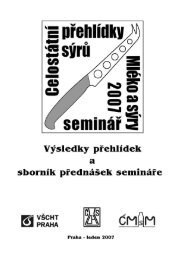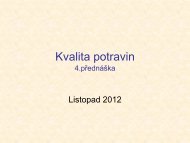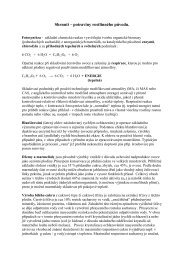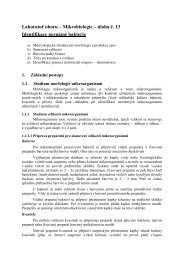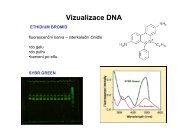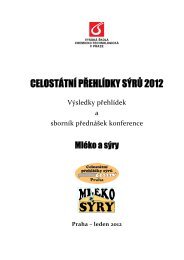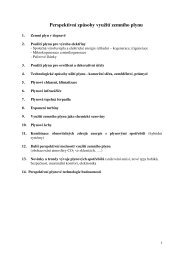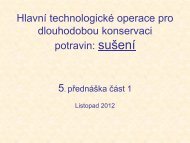Selective enumeration and identification of mixed cultures of ...
Selective enumeration and identification of mixed cultures of ...
Selective enumeration and identification of mixed cultures of ...
You also want an ePaper? Increase the reach of your titles
YUMPU automatically turns print PDFs into web optimized ePapers that Google loves.
International Dairy Journal 17 (2007) 1107–1114<br />
<strong>Selective</strong> <strong>enumeration</strong> <strong>and</strong> <strong>identification</strong> <strong>of</strong> <strong>mixed</strong> <strong>cultures</strong> <strong>of</strong><br />
Streptococcus thermophilus, Lactobacillus delbrueckii subsp. bulgaricus,<br />
L. acidophilus, L. paracasei subsp. paracasei <strong>and</strong><br />
Bifidobacterium lactis in fermented milk<br />
Abstract<br />
R. Tabasco, T. Paarup, C. Janer, C. Pela´ez, T. Requena<br />
Department <strong>of</strong> Dairy Science <strong>and</strong> Technology, Instituto del Frío (CSIC), Jose Antonio Novais 10, 28040 Madrid, Spain<br />
Received 11 October 2006; accepted 19 January 2007<br />
This study describes selective plating methodologies for <strong>enumeration</strong> <strong>of</strong> <strong>mixed</strong> <strong>cultures</strong> <strong>of</strong> Streptococcus thermophilus, Lactobacillus<br />
delbrueckii subsp. bulgaricus, L. acidophilus, L. paracasei subsp. paracasei <strong>and</strong> Bifidobacterium lactis in fermented milk based on selective<br />
antibiotic-free media. Enumeration <strong>of</strong> S. thermophilus was performed using M17-lactose. MRS-fructose was suitable for <strong>enumeration</strong> <strong>of</strong><br />
L. bulgaricus <strong>and</strong> MRS-maltose for differentiation between L. acidophilus <strong>and</strong> L. paracasei. The selective <strong>enumeration</strong> <strong>of</strong> B. lactis was<br />
obtained using MRS-raffinose containing 0.05% LiCl. The bacterial counts obtained using selective methods were equivalent to those<br />
under optimum culture conditions at a probability level <strong>of</strong> 95%. Performance <strong>of</strong> the methods was verified in fermented milk products<br />
where <strong>identification</strong> <strong>of</strong> the enumerated species was confirmed by species-specific polymerase chain reaction. This study shows that<br />
combination <strong>of</strong> species-specific polymerase chain reaction (PCR) <strong>and</strong> denaturing gradient gel electrophoresis (DGGE) analysis has great<br />
detection <strong>and</strong> <strong>identification</strong> potential for verification <strong>of</strong> accurate species labelling in fermented milk without prior isolation <strong>of</strong> the<br />
bacteria.<br />
r 2007 Elsevier Ltd. All rights reserved.<br />
Keywords: <strong>Selective</strong> methods; Lactobacilli; Bifidobacteria; Fermented milk; PCR-DGGE<br />
1. Introduction<br />
The CODEX st<strong>and</strong>ard for fermented milk products<br />
(CODEX STAN 243-2003) establishes them as the<br />
products obtained by fermentation <strong>of</strong> milk by the action<br />
<strong>of</strong> suitable starter microorganisms that should be viable,<br />
active <strong>and</strong> abundant in the product to the date <strong>of</strong> minimum<br />
durability (Codex Alimentarius Commission, 2003). The<br />
name yoghurt should be used when the milk is only<br />
fermented by Streptococcus thermophilus <strong>and</strong> Lactobacillus<br />
delbrueckii subsp. bulgaricus. Regarding viability, the norm<br />
specifies that the sum <strong>of</strong> microorganisms constituting the<br />
starter culture should be at least 10 7 cfu g 1 , <strong>and</strong> that<br />
minimum counts <strong>of</strong> other labelled microorganisms should<br />
Corresponding author. Tel.: +34 915492300; fax: +34 915493627.<br />
E-mail address: trequena@if.csic.es (T. Requena).<br />
0958-6946/$ - see front matter r 2007 Elsevier Ltd. All rights reserved.<br />
doi:10.1016/j.idairyj.2007.01.010<br />
ARTICLE IN PRESS<br />
www.elsevier.com/locate/idairyj<br />
be 10 6 cfu g 1 . Therefore, microbial viability <strong>and</strong> authenticity<br />
are prominent criteria to be analytically verified for<br />
the compliance <strong>of</strong> fermented milk with the required<br />
product specifications. Likewise, probiotics are defined as<br />
live microorganisms which when administered in adequate<br />
amounts confer a health benefit in the host (FAO/WHO,<br />
2002). However, the minimum amount <strong>of</strong> probiotics<br />
needed to obtain a clinical effect has not been established.<br />
As more information on probiotics is available, it seems<br />
likely that numbers will vary as a function <strong>of</strong> the strain <strong>and</strong><br />
the health effect desired (Roy, 2005).<br />
Fermented milk products are the most popular means <strong>of</strong><br />
delivering probiotic bacteria in food. Among them, strains<br />
<strong>of</strong> L. acidophilus, L. casei complex <strong>and</strong> Bifidobacterium<br />
lactis predominate in commercial probiotic products<br />
(Fasoli et al., 2003; Gueimonde et al., 2004; Masco, Huys,<br />
De Br<strong>and</strong>t, Temmerman, & Swings, 2005; Yeung, S<strong>and</strong>ers,
1108<br />
Kitts, Cano, & Tong, 2002). The presence <strong>of</strong> multiple <strong>and</strong><br />
closely related species in these products makes the<br />
differential <strong>enumeration</strong> <strong>of</strong> probiotic <strong>and</strong> yoghurt starter<br />
bacteria difficult due to similarity in growth requirements<br />
<strong>and</strong> overlapping biochemical pr<strong>of</strong>iles <strong>of</strong> the species.<br />
Numerous media have been proposed for selective <strong>and</strong><br />
differential <strong>enumeration</strong> <strong>of</strong> lactobacilli <strong>and</strong> bifidobacteria<br />
in <strong>mixed</strong> bacterial populations, <strong>and</strong> some have been the<br />
subject <strong>of</strong> specific reviews (Charteris, Kelly, Morelli, &<br />
Collins, 1997; Shah, 2000; Roy, 2001; Coeuret, Dubernet,<br />
Bernardeau, Gueguen, & Vernoux, 2003) <strong>and</strong> <strong>of</strong> comparative<br />
performance analyses (Payne, Morris, & Beers, 1999;<br />
Talwalkar & Kailasapathy, 2004; Masco et al., 2005; Van<br />
de Casteele et al., 2006). In order to cover a high spectrum<br />
<strong>of</strong> species, most media for selective <strong>enumeration</strong> <strong>of</strong> <strong>mixed</strong><br />
<strong>cultures</strong> have complex compositions that include antibiotics<br />
as selective ingredients, which could impact on the<br />
response <strong>of</strong> not only the sensitive strains but also <strong>of</strong> target<br />
bacteria <strong>and</strong> result in inaccurate or irreproducible quantitative<br />
results. A comparison <strong>of</strong> methods described in<br />
literature (Talwalkar & Kailasapathy, 2004) concluded that<br />
no reliable techniques are yet developed to accurately<br />
enumerate L. acidophilus, L. casei <strong>and</strong> Bifidobacterium in<br />
different commercial yoghurts. Overall, it seems rational<br />
that the choice <strong>of</strong> selective methods should focus on the<br />
type <strong>of</strong> food <strong>and</strong> the species, even strains, to enumerate in<br />
each particular situation (Lourens-Hattingh & Viljoen,<br />
2001; Sartory, 2005).<br />
As previously stated, <strong>identification</strong> <strong>of</strong> species is another<br />
important issue to be verified for the compliance <strong>of</strong><br />
fermented milk with the required product specifications<br />
in terms <strong>of</strong> accurate species labelling <strong>and</strong>, if appropriate, to<br />
support health claims that could be associated with added<br />
probiotics. Phenotypic methods alone are inadequate for<br />
<strong>identification</strong> <strong>of</strong> lactobacilli <strong>and</strong> bifidobacteria species<br />
(Dellaglio & Felis, 2005). To achieve a rapid <strong>and</strong> reliable<br />
<strong>identification</strong> <strong>of</strong> species, polymerase chain reaction (PCR)based<br />
methods using species-specific primers targeting the<br />
16S rRNA gene sequence diversity have become very<br />
popular (Coeuret et al., 2003). In addition, cultureindependent<br />
methods for bacterial <strong>identification</strong> based on<br />
genetic analysis have become a valuable tool, since these<br />
techniques have the advantage to analyze the product as a<br />
whole. Separation <strong>of</strong> genus or species-specific PCR<br />
products by denaturing gradient gel electrophoresis<br />
(DGGE) has become the most commonly used technique<br />
among the culture-independent methods for detection <strong>and</strong><br />
<strong>identification</strong> <strong>of</strong> lactobacilli <strong>and</strong> bifidobacteria from<br />
fermented products (Ercolini, 2004).<br />
The aim <strong>of</strong> this study was to develop selective plating<br />
methodologies for <strong>enumeration</strong> <strong>and</strong> <strong>identification</strong> <strong>of</strong> <strong>mixed</strong><br />
<strong>cultures</strong> <strong>of</strong> S. thermophilus, L. delbrueckii subsp. bulgaricus,<br />
L. acidophilus, L. paracasei subsp. paracasei <strong>and</strong> B. lactis in<br />
fermented milk products based on selective antibiotic-free<br />
media <strong>and</strong> different incubation conditions. To evaluate the<br />
performance <strong>of</strong> selective media for complete recovery <strong>of</strong><br />
viable bacteria, methods were validated on the basis <strong>of</strong><br />
ARTICLE IN PRESS<br />
R. Tabasco et al. / International Dairy Journal 17 (2007) 1107–1114<br />
their precision, accuracy, reproducibility, selectivity <strong>and</strong><br />
specificity characteristics, in relation to culture conditions,<br />
which were used as reference methods. Efficacy <strong>of</strong> the<br />
selective methods was verified by <strong>identification</strong> <strong>of</strong> the<br />
presumptive colonies using species-specific PCR. The study<br />
is also complemented with the application <strong>of</strong> a cultureindependent<br />
procedure based on PCR–DGGE analysis to<br />
the rapid detection <strong>and</strong> <strong>identification</strong> <strong>of</strong> the <strong>mixed</strong> species<br />
in fermented milk products.<br />
2. Material <strong>and</strong> methods<br />
2.1. Microorganisms <strong>and</strong> culture conditions<br />
Strains used in the assay were S. thermophilus STY-31,<br />
L. delbrueckii subsp. bulgaricus LBY-27, L. acidophilus LA-<br />
5, L. paracasei subsp. paracasei LC-01, <strong>and</strong> B. lactis BB-12.<br />
The strains were purified from a commercial synbiotic<br />
product (Simbiotic Drink; Prie´gola, Madrid, Spain). To<br />
allow the correct <strong>identification</strong> <strong>of</strong> strains, 16S rRNA gene<br />
nucleotide sequencing was carried out from pure <strong>cultures</strong>.<br />
The entire gene was amplified using the primers SacI-<br />
POmod <strong>and</strong> SalI-T7-PC5 (Table 1) <strong>and</strong> the PCR conditions<br />
described previously by Rodtong <strong>and</strong> Tannock<br />
(1993). Additional primers used to assist in sequencing<br />
were 16Smidfor <strong>and</strong> P3rev (Table 1). Sequencing <strong>of</strong> PCR<br />
fragments was carried out for both str<strong>and</strong>s at the DNA<br />
Sequence Service <strong>of</strong> the Centro de Investigaciones Biolo´gicas-CSIC<br />
(Madrid, Spain). S. thermophilus was grown in<br />
M-17 broth (Pronadisa, Madrid, Spain) containing 2%<br />
lactose. Lactobacillus subsp. <strong>and</strong> B. lactis were grown<br />
under anaerobic conditions (Gas-Pack, Anaerogen; Oxoid<br />
Ltd., Hampshire, Engl<strong>and</strong>) in MRS broth (Pronadisa)<br />
supplemented with 0.05% L-cysteine hydrochloride, excepting<br />
L. paracasei subsp. paracasei that was grown<br />
aerobically in MRS broth. Incubations were carried out for<br />
18–24 h at 37 1C <strong>and</strong> at 30 1C for L. paracasei subsp.<br />
paracasei.<br />
2.2. <strong>Selective</strong> methods<br />
Culture conditions described above were selected as<br />
reference methods. Media were supplemented with 1.5%<br />
bacteriological agar (Scharlab, Barcelona, Spain) <strong>and</strong><br />
incubation extended to 48 h for S. thermophilus <strong>and</strong> 72 h<br />
for B. lactis <strong>and</strong> lactobacilli.<br />
The selective conditions for the <strong>enumeration</strong> <strong>of</strong><br />
S. thermophilus included inoculation <strong>of</strong> appropriate dilutions<br />
by the pour-plate technique into M-17 agar containing 1%<br />
lactose (M17-lactose) <strong>and</strong> incubation at 45 1C for 24 h. For<br />
<strong>enumeration</strong> <strong>of</strong> L. delbrueckii subsp. bulgaricus, appropriate<br />
dilutions were pour-plated into MRS fermentation<br />
broth (Pronadisa), which does not contain either glucose or<br />
meat extract (De Man, Rogosa, & Sharpe, 1960), enriched<br />
with 0.2% Tween 80 <strong>and</strong> supplemented with 1% fructose,<br />
0.8% casein acid hydrolysate, 0.05% cysteine, <strong>and</strong> 1.5%<br />
agar (MRS-fructose). Plates were incubated in anaerobic
jars at 45 1C for 72 h <strong>and</strong> lenticular colonies with 1–2 mm<br />
diameter were enumerated as L. delbrueckii subsp. bulgaricus,<br />
whereas cottony–fluffy colonies <strong>of</strong> 2–3 mm diameter<br />
corresponded to L. acidophilus (Fig. 1a). Enumeration <strong>of</strong><br />
L. acidophilus was performed by spreading out appropriate<br />
dilutions onto MRS fermentation broth enriched with<br />
0.2% Tween 80 <strong>and</strong> supplemented with 1% maltose,<br />
0.05% cysteine, <strong>and</strong> 1.5% agar (MRS-maltose). Plates<br />
were incubated in a 20% CO 2 atmosphere incubator at<br />
37 1C for 72 h. Flat, rough colonies with irregular edges <strong>and</strong><br />
1–2 mm diameter corresponded to L. acidophilus, whereas<br />
L. paracasei subsp. paracasei developed as white, smooth<br />
<strong>and</strong> circular colonies <strong>of</strong> 2–3 mm diameter (Fig. 1b). The<br />
method was also selected for the <strong>enumeration</strong> <strong>of</strong><br />
L. paracasei subsp. paracasei. Enumeration <strong>of</strong> B. lactis<br />
was carried out by pour-plating appropriate dilutions into<br />
MRS fermentation broth supplemented with 1% raffinose,<br />
0.05% LiCl, 0.05% cysteine, <strong>and</strong> 1.5% agar (MRSraffinose).<br />
Plates were incubated in anaerobic jars at<br />
45 1C for72h.<br />
ARTICLE IN PRESS<br />
Table 1<br />
Polymerase chain reaction primers used in this study for the <strong>identification</strong> <strong>of</strong> S. thermophilus, L. delbrueckii subsp. bulgaricus, L. acidophilus, L. paracasei<br />
subsp. paracasei <strong>and</strong> B. lactis<br />
Species Name Sequence 5 0 -3 0 Product (bp)<br />
S. thermophilus Thermfor ACGCTGAAGAGAGGAGCTTG 157<br />
Thermrev GCAATTGCCCCTTTCAAATA<br />
L. bulgaricus Bulgfor TCAAAGATTCCTTCGGGATG 232<br />
Bulgrev TACGCATCATTGCCTTGGTA<br />
L. acidophilus Acidfor AGCGAGCTGAACCAACAGAT 227<br />
Acidrev AGGCCGTTACCCTACCAACT<br />
L. paracasei Casfor GCACCGAGATTCAACATGGAA 142<br />
Casrev GCCATCTTTCAGCCAAGAACC<br />
B. lactis Forlac GCGCTGGGCTGCTCTGGAAGC 116<br />
Revlac TGGCGACGAGCTCATCGACATACT<br />
All species SacI-POmod CCGAGCTCAACAGAGTTTGATCCTGGCTCAG 792–825 a<br />
P3rev GGACTACCAGGGTATCTAAT<br />
16Smidfor GGCCGTTACTGACGCTGAG 767–771 a<br />
SalI-T7-PC5 GGTCGACCGTTAATACGACTCACTATAGGGATACCTTGTTACGACTT<br />
a Size range <strong>of</strong> products obtained from the five species.<br />
R. Tabasco et al. / International Dairy Journal 17 (2007) 1107–1114 1109<br />
Fig. 1. Differentiation <strong>of</strong> L. acidophilus from L. delbrueckii subsp. bulgaricus <strong>and</strong> B. lactis on MRS-fructose agar (a) <strong>and</strong> from L. paracasei subps.<br />
paracasei on MRS-maltose agar (b).<br />
2.3. Efficiency tests<br />
To evaluate performance <strong>of</strong> the selective methods to<br />
enumerate lactic acid bacteria (LAB) <strong>and</strong> B. lactis,<br />
recommendations <strong>of</strong> the ISO/TR 13843 (ISO, 2000) <strong>and</strong><br />
ISO/IEC 17025 (ISO, 2005) st<strong>and</strong>ards on validation <strong>of</strong><br />
microbiological methods were followed. Parameters evaluated<br />
were precision, accuracy, reproducibility, selectivity<br />
<strong>and</strong> specificity. The precision <strong>and</strong> accuracy <strong>of</strong> the methods<br />
were determined by the comparison between the bacterial<br />
counts obtained with selective <strong>and</strong> reference methods.<br />
Overnight pure <strong>cultures</strong> were diluted <strong>and</strong> inoculated into<br />
both selective <strong>and</strong> reference media. After logarithmic<br />
transformation <strong>of</strong> the results to normalize the distribution,<br />
counts obtained in both media were compared using paired<br />
Student’s t-test to obtain t exp ¼ d m/(s d/n 1/2 ), where d m is the<br />
mean <strong>of</strong> differences (d) between counts on selective <strong>and</strong><br />
reference methods, sd is the st<strong>and</strong>ard deviation <strong>of</strong> d, <strong>and</strong> n<br />
the number <strong>of</strong> samples. Other parameters calculated were<br />
relative recovery ¼ 10 dm <strong>and</strong> relative st<strong>and</strong>ard deviation
1110<br />
<strong>of</strong> differences ¼ 1 10 sd . Reproducibility <strong>of</strong> the methods<br />
was tested by the analysis <strong>of</strong> identical samples by two<br />
different operators <strong>and</strong> using different equipments. At the<br />
same time, the matrix effect for bacterial <strong>enumeration</strong> in<br />
fermented milk was evaluated. Samples consisted <strong>of</strong> 10%<br />
reconstituted skim milk powder (Scharlab) acidified to pH<br />
4.6 with 5 M lactic acid <strong>and</strong> inoculated with each species<br />
at both, high levels (10 7 cfu mL 1 ) <strong>and</strong> low levels<br />
(10 5 cfu mL 1 ). Pairs <strong>of</strong> counts were compared <strong>and</strong> the<br />
relative st<strong>and</strong>ard deviation <strong>of</strong> reproducibility was calculated<br />
as 1 10 sdr , where sdr is the st<strong>and</strong>ard deviation <strong>of</strong><br />
differences between counts from the two operators. For<br />
selectivity <strong>and</strong> specificity analysis, <strong>cultures</strong> from all five<br />
bacterial species were <strong>mixed</strong> at the level <strong>of</strong> 10 7 cfu mL 1 for<br />
each strain <strong>and</strong> appropriate dilutions inoculated into the<br />
selective media. Results were expressed as the percentage <strong>of</strong><br />
the presumptive target counts in relation to theoretical<br />
counts. In addition, 10% reconstituted skim milk, pH 4.6,<br />
was inoculated with <strong>cultures</strong> <strong>of</strong> each target strain at low<br />
level (10 5 cfu mL 1 ) <strong>and</strong> <strong>mixed</strong> with the other four strains<br />
at high level (10 7 cfu mL 1 ). Appropriate dilutions were<br />
plated <strong>and</strong> analysed for the presence <strong>of</strong> presumptive false<br />
positive <strong>and</strong> negative colonies. All analyses were performed<br />
at least in triplicate <strong>and</strong> differences were compared at a<br />
significance level <strong>of</strong> 0.05 by a Student’s t-test using Excel<br />
s<strong>of</strong>tware (Micros<strong>of</strong>t, Redmond, WA, USA).<br />
2.4. Analysis <strong>of</strong> fermented milk products<br />
2.4.1. Enumeration <strong>of</strong> bacterial viable counts<br />
The fermented milk Simbiotic Drink containing the<br />
yoghurt <strong>and</strong> probiotic strains <strong>and</strong> the product with only<br />
the yoghurt bacteria, both from Prie´gola, were analysed<br />
through their shelf life (28 d) for performance <strong>of</strong> the<br />
selective methods. Viable counts were determined in<br />
samples (1 mL) by using serial decimal dilutions prepared<br />
in Ringer’s solution (Scharlab) supplemented with 0.05%<br />
cysteine. Appropriate dilutions were plated in duplicate<br />
<strong>and</strong> analysed using the selective methods described above.<br />
2.4.2. Identification <strong>of</strong> presumptive target colonies<br />
Presumptive positive colonies (10%) grown with selective<br />
methods in the highest dilution plate were checked by<br />
species-specific PCR to verify the efficacy <strong>of</strong> the media for<br />
specific <strong>enumeration</strong>. Species-specific primers were designed<br />
within variable regions in the 16S rRNA encoding<br />
genes <strong>of</strong> S. thermophilus, L. paracasei subsp. paracasei, L.<br />
delbrueckii subsp. bulgaricus <strong>and</strong> L. acidophilus using the<br />
Lasergene PrimerSelect module <strong>of</strong> the Lasergene s<strong>of</strong>tware<br />
package (DNAStar Inc., Madison, WI, USA). Speciesspecific<br />
primers for <strong>identification</strong> <strong>of</strong> B. lactis were designed<br />
on the basis <strong>of</strong> the transaldolase gene variable regions<br />
(Requena et al., 2002). Primer pairs (Table 1) were selected<br />
upon confirmation that only targeted species would give a<br />
PCR product. Colonies were picked up using sterile<br />
toothpicks, suspended in 20 mL milliQ water, boiled at<br />
100 1C for 5 min <strong>and</strong> frozen at 20 1C. Diagnostic PCR<br />
ARTICLE IN PRESS<br />
R. Tabasco et al. / International Dairy Journal 17 (2007) 1107–1114<br />
reactions were carried out with 2 mL <strong>of</strong> thawed cell<br />
suspensions <strong>and</strong> the primers described in Table 1. The<br />
amplification programme was as follows: 94 1C for 3 min,<br />
35 cycles <strong>of</strong> 94 1C for 30 s, 60 1C for 20 s <strong>and</strong> 72 1C for 20 s,<br />
<strong>and</strong> a final extension time <strong>of</strong> 72 1C for 5 min.The products<br />
(5 mL) were separated on a 2% agarose gel <strong>and</strong> analysed for<br />
the yield <strong>of</strong> amplicons with the expected sizes (Table 1).<br />
2.4.3. PCR–DGGE analysis<br />
In order to obtain bacterial DNA from fermented milk,<br />
the samples (3 mL) were neutralized to pH 6.5 with 1 M<br />
NaOH <strong>and</strong> cleared by adding 10 mL <strong>of</strong> 0.2% EDTA,<br />
pH 12, to cause casein micelle dispersion. The bacterial cells<br />
were collected by centrifugation at 10,000 g for 15 min <strong>and</strong><br />
<strong>mixed</strong> (1:1) with glass beads (diameter, 150–212 mm; Sigma<br />
Chemical Co., St. Louis, MO, USA) for mechanical<br />
disruption by vortexing the ice-cooled suspensions four<br />
times over 4 min. Cell debris <strong>and</strong> glass beads were collected<br />
by centrifugation (12,000 g for 5 min) <strong>and</strong> genomic DNA<br />
was obtained from the cell free extract as described by<br />
Meile, Rohr, Geissman, Herensperger, <strong>and</strong> Teuber (2001).<br />
The DNA was used as template (500ng) for PCR<br />
amplification using the conditions described above. A 40bp<br />
GC clamp (5 0 -CGC CCG GGG CGC GCC CCG GGC<br />
GGG GCG GGG GCA CGG GGG G-3 0 ) was attached to<br />
either the forward or reverse primer (Table 1) to obtain<br />
PCR products suitable for separation by DGGE. Thus, the<br />
following species-specific primers were employed: Thermfor-GC<br />
<strong>and</strong> Thermrev for the <strong>identification</strong> <strong>of</strong> S. thermophilus,<br />
Bulgfor <strong>and</strong> Bulgrev-GC for L. delbrueckii subsp.<br />
bulgaricus, Acidfor-GC <strong>and</strong> Acidrev for L. acidophilus,<br />
Casfor-GC <strong>and</strong> Casrev for L. paracasei subsp. paracasei,<br />
<strong>and</strong> Forlac <strong>and</strong> Revlac-GC for B. lactis. An <strong>identification</strong><br />
ladder containing equal amounts <strong>of</strong> PCR products from<br />
pure <strong>cultures</strong> was prepared.<br />
DGGE was performed with a DCode system (Bio-Rad<br />
Laboratories, Hercules, CA, USA), using a 9% polyacrylamide<br />
gel with a 40–60% gradient <strong>of</strong> 7 M urea <strong>and</strong> 40%<br />
formamide that increased in the electrophoresis running<br />
direction. Electrophoresis was carried out in 20 mM Tris,<br />
10 mM acetic acid <strong>and</strong> 0.5 mM EDTA (0.5 TAE) buffer at<br />
130 V <strong>and</strong> 60 1C for 4.5 h. Gels were stained with AgNO3 as<br />
described by Sanguinetti, Dias-Neto, <strong>and</strong> Simpson (1994).<br />
3. Results <strong>and</strong> discussion<br />
3.1. Comparison <strong>of</strong> bacterial counts using selective <strong>and</strong><br />
reference methods<br />
This study has focused on the development <strong>of</strong> selective<br />
methods suited to recover the maximum population<br />
<strong>of</strong> S. thermophilus, L. delbrueckii subsp. bulgaricus,<br />
L. acidophilus, L. paracasei subsp. paracasei <strong>and</strong> B. lactis<br />
in fermented milk as compared with that <strong>of</strong> supporting<br />
optimal growth (reference methods) to avoid underestimation<br />
<strong>of</strong> the bacterial counts. Therefore, formulation <strong>of</strong> the<br />
methods was based on antibiotic-free media, carbohydrate
fermentation patterns <strong>and</strong> different incubation conditions.<br />
Incubation in aerobiosis at 45 1C during 24 h in M17lactose<br />
agar was found suitable for selective <strong>enumeration</strong><br />
<strong>of</strong> S. thermophilus, since it prevented the growth <strong>of</strong><br />
L. paracasei subsp. paracasei found at 37 1C <strong>and</strong> that <strong>of</strong><br />
L. delbrueckii subsp. bulgaricus <strong>and</strong> B. lactis that developed<br />
under anaerobic conditions. Extension <strong>of</strong> the incubation<br />
period for 48 h allowed the appearance <strong>of</strong> pinpoint colonies<br />
<strong>of</strong> L. acidophilus. Therefore, these incubation conditions<br />
provided selective characteristics for S. thermophilus<br />
<strong>enumeration</strong>, although the medium does not inhibit the<br />
growth <strong>of</strong> the other bacteria.<br />
The finding <strong>of</strong> a non-antibiotic medium for selective<br />
<strong>enumeration</strong> <strong>of</strong> L. delbrueckii subsp. bulgaricus could not<br />
be based on the acidified MRS medium recommended by<br />
ISO/FDIS 7889 IDF 117 st<strong>and</strong>ard on <strong>enumeration</strong> <strong>of</strong><br />
yoghurt characteristic microorganisms (ISO, 2002), since it<br />
also allowed growth <strong>of</strong> L. acidophilus, L. paracasei subsp.<br />
paracasei, <strong>and</strong>B. lactis. Increasing the incubation at 45 1C<br />
<strong>and</strong> replacement <strong>of</strong> glucose by fructose were conditions<br />
selective against L. paracasei subsp. paracasei <strong>and</strong> B. lactis,<br />
respectively. The method was differential against<br />
L. acidophilus when the medium was enriched with 0.2%<br />
Tween 80, showing a clear morphological differentiation<br />
between lenticular colonies corresponding to L. delbrueckii<br />
subsp. bulgaricus <strong>and</strong> cottony-fluffy colonies <strong>of</strong> L. acidophilus<br />
(Fig. 1a). The role <strong>of</strong> the compound to cause such<br />
peculiar colony morphology in L. acidophilus was not<br />
elucidated. <strong>Selective</strong> <strong>enumeration</strong> <strong>of</strong> L. acidophilus against<br />
S. thermophilus <strong>and</strong> B. lactis in fermented milk using MRSmaltose<br />
<strong>and</strong> incubation in a 20% CO2 atmosphere was<br />
shown in a previous report (Martı´n-Diana, Janer, Pela´ez,<br />
& Requena, 2003). In the present study, the method also<br />
demonstrated to be selective against L. delbrueckii subsp.<br />
bulgaricus <strong>and</strong> differential against L. paracasei subsp.<br />
paracasei, since a clear difference in colony morphology<br />
could be assessed in the plates (Fig. 1b). Counts <strong>of</strong><br />
L. acidophilus were similar when the two methods, growth<br />
in MRS-maltose <strong>and</strong> MRS-fructose, were compared (results<br />
not shown). MRS-maltose was also selected as suitable for<br />
<strong>enumeration</strong> <strong>of</strong> L. paracasei subsp. paracasei since it gave<br />
ARTICLE IN PRESS<br />
excellent results compared with the reference method<br />
(Table 2).<br />
MRS containing cysteine–HCl can provide optimal<br />
overall growth conditions for the non-selective <strong>enumeration</strong><br />
<strong>of</strong> bifidobacteria (Roy, 2001; Leuschner, Bew,<br />
Simpson, Ross, & Stanton, 2003), <strong>and</strong> it was therefore<br />
selected as reference medium for B. lactis. <strong>Selective</strong><br />
conditions for <strong>enumeration</strong> <strong>of</strong> this species were incubation<br />
at 45 1C, use <strong>of</strong> raffinose as a carbohydrate source <strong>and</strong><br />
addition <strong>of</strong> 0.05% LiCl to suppress lactobacilli growth.<br />
The method was selective for B. lactis against the LAB<br />
strains studied. Overall characteristics <strong>of</strong> the method<br />
allowed reduction <strong>of</strong> the concentration <strong>of</strong> the antimicrobial<br />
compound LiCl to 0.05% instead <strong>of</strong> 0.2–0.3%, the amount<br />
usually added in selective media for <strong>enumeration</strong> <strong>of</strong><br />
Bifidobacteria (Hartemink, Kok, Weenk, & Rombouts,<br />
1996; Payne et al., 1999; Roy, 2001).<br />
The Student’s t-test was used to compare each species<br />
<strong>enumeration</strong> on both methods (reference <strong>and</strong> selective).<br />
The resulting t values (Table 2) were lower than the<br />
tabulated value <strong>of</strong> t (t tab ¼ 2.29) in all cases, which<br />
indicates that there were no significant differences between<br />
the two methods in bacterial <strong>enumeration</strong> at a probability<br />
level <strong>of</strong> 95%. The highest relative st<strong>and</strong>ard deviation <strong>of</strong><br />
differences in counts between methods was observed for<br />
L. delbrueckii subsp. bulgaricus. Ingeneral,higherL. delbrueckii<br />
subsp. bulgaricus counts were found at 45 1C than<br />
at 37 1C (results not shown). Optimum temperature growth<br />
at 44 1C for L. delbrueckii subsp. bulgaricus has been<br />
previously reported (Beal, Louvet, & Corrieu, 1989), <strong>and</strong> a<br />
recommendation to increase temperature incubation for<br />
L. delbrueckii subsp. bulgaricus slowly growing strains is<br />
included in the ISO/FDIS 7889 IDF 117 st<strong>and</strong>ard on<br />
yoghurt colony count technique at 37 1C (ISO, 2002).<br />
Reproducibility <strong>of</strong> the methods was tested by the analysis<br />
<strong>of</strong> identical samples, acidified milk (pH 4.6) inoculated with<br />
each species at both high level (10 7 cfu mL 1 )<strong>and</strong>lowlevel<br />
(10 5 cfu mL 1 ), by two different operators <strong>and</strong> using<br />
different equipment. As shown in Table 2, the relative<br />
st<strong>and</strong>ard deviation <strong>of</strong> reproducibility was equal or lower<br />
than 0.14 log units.<br />
Table 2<br />
Counts (log cfu mL –1 ) <strong>and</strong> evaluation <strong>of</strong> performance <strong>of</strong> the selective methods to enumerate S. thermophilus, L. delbrueckii subsp. bulgaricus,<br />
L. acidophilus, L. paracasei subsp. paracasei <strong>and</strong> B. lactis<br />
Parameter S. thermophilus L. bulgaricus L. acidophilus L. paracasei B. lactis<br />
Mean a (log cfu mL –1 ) <strong>of</strong> reference method 9.02 7.74 7.35 9.39 8.75<br />
Mean a (log cfu mL –1 ) <strong>of</strong> selective method 9.01 8.04 7.34 9.41 8.78<br />
Relative st<strong>and</strong>ard deviation <strong>of</strong> differences 0.08 0.47 0.08 0.10 0.12<br />
Student’s t b<br />
0.70 1.58 0.53 0.52 0.76<br />
Relative recovery 0.97 2.02 0.97 1.03 1.07<br />
Relative st<strong>and</strong>ard deviation <strong>of</strong> reproducibility 0.14 0.13 0.13 0.07 0.08<br />
Selectivity (%) 101.8 103.9 100.7 101.1 97.6<br />
a Means are average from three independent analyses.<br />
b ttab ¼ 2.29.<br />
R. Tabasco et al. / International Dairy Journal 17 (2007) 1107–1114 1111
1112<br />
To verify the selectivity <strong>of</strong> the methods, <strong>cultures</strong> <strong>of</strong><br />
S. thermophilus, L. delbrueckii subsp. bulgaricus, L. acidophilus,<br />
L. paracasei subsp. paracasei <strong>and</strong> B. lactis were <strong>mixed</strong><br />
at approximately 10 7 cfu mL 1 in the ratio <strong>of</strong> 0.2, 1, 5, 0.2,<br />
<strong>and</strong> 1, respectively, <strong>and</strong> appropriate dilutions plated into<br />
the selective media. The results, expressed as the percentage<br />
<strong>of</strong> presumptive target counts in relation to theoretical<br />
counts, are shown in Table 2. Percentages close to 100%<br />
indicate that the selective methods yielded counts that were<br />
nearly equal to the theoretical counts, which indicates that<br />
the efficacy <strong>of</strong> the methods for selective <strong>enumeration</strong> <strong>of</strong> the<br />
five species in <strong>mixed</strong> <strong>cultures</strong> could be considered<br />
acceptable. Specificity <strong>and</strong> selectivity <strong>of</strong> the methods were<br />
also analysed in acidified milk, pH 4.6, that was inoculated<br />
with <strong>cultures</strong> <strong>of</strong> each target strain at low level<br />
(10 5 cfu mL 1 ) <strong>and</strong> the other four strains at high level<br />
(10 7 cfu mL 1 ). There was no interference between species for<br />
the <strong>enumeration</strong> <strong>of</strong> S. thermophilus <strong>and</strong> B. lactis in the<br />
corresponding selective media, <strong>and</strong> for L. paracasei subsp.<br />
paracasei when it was incubated in aerobiosis at 30 1C for<br />
48 h in MRS agar. However, differential <strong>enumeration</strong> <strong>of</strong><br />
L. delbrueckii subsp. bulgaricus <strong>and</strong> L. acidophilus in MRSfructose<br />
(Fig. 1a) <strong>and</strong><strong>of</strong>L. acidophilus <strong>and</strong> L. paracasei<br />
subsp. paracasei in MRS-maltose (Fig. 1b) could only be<br />
made when differences <strong>of</strong> counts between the two species<br />
were lower than 2 log units (results not shown).<br />
3.2. Enumeration <strong>of</strong> bacteria in fermented milk products<br />
using the selective methods<br />
The performance <strong>of</strong> the methods for selective <strong>enumeration</strong><br />
<strong>of</strong> yoghurt <strong>and</strong> probiotic bacteria was carried out in<br />
the commercial probiotic product Simbiotic Drink (Prie´gola),<br />
containing S. thermophilus, L. delbrueckii subsp.<br />
bulgaricus, L. acidophilus, L. paracasei subsp. paracasei <strong>and</strong><br />
B. lactis as stated in the label, <strong>and</strong> the product manufactured<br />
with only the yoghurt bacteria. Results in Table 3 are<br />
averages from eight batches <strong>of</strong> each product analysed over<br />
4 weeks. The results obtained indicated that there was low<br />
Table 3<br />
Viable counts <strong>of</strong> S. thermophilus, L. delbrueckii subsp. bulgaricus,<br />
L. acidophilus, L. paracasei subsp. paracasei <strong>and</strong> B. lactis in probiotic<br />
fermented milk <strong>and</strong> yoghurt through storage at 4 1C during four weeks<br />
Species Counts (cfu mL 1 ) in fermented milk stored at 4 1C<br />
1wk 2wk 3wk 4wk<br />
Probiotic fermented milk<br />
S. thermophilus 9.32 (0.09) 9.15 (0.18) 9.22 (0.14) 9.14 (0.37)<br />
L. bulgaricus 7.58 (0.28) 7.36 (0.53) 7.63 (0.07) 6.05 (1.03)<br />
L. acidophilus 7.12 (0.30) 7.11 (0.33) 6.81 (0.33) 6.44 (0.36)<br />
L. paracasei 6.49 (0.12) 6.48 (0.27) 6.49 (0.13) 6.47 (0.21)<br />
B. lactis 8.08 (0.13) 8.03 (0.22) 7.97 (0.22) 8.15 (0.15)<br />
Yoghurt<br />
S. thermophilus 8.88 (0.12) 8.91 (0.46) 8.98 (0.22) 8.94 (0.05)<br />
L. bulgaricus 8.26 (0.11) 8.35 (0.13) 8.23 (0.13) 8.21 (0.07)<br />
a Means are average from eight batches. St<strong>and</strong>ard deviation in parenthesis.<br />
ARTICLE IN PRESS<br />
R. Tabasco et al. / International Dairy Journal 17 (2007) 1107–1114<br />
variation between production batches, reliable counts for<br />
the probiotic <strong>and</strong> yoghurt strains <strong>and</strong> acceptable viability<br />
<strong>of</strong> the species throughout the shelf life <strong>of</strong> the products. The<br />
selective methods were therefore suitable for <strong>enumeration</strong><br />
<strong>of</strong> the species, mostly because they were evaluated for the<br />
specific microorganisms present in the product. The results<br />
strengthen the rising opinion that selective or differential<br />
media should be evaluated for the specific strains <strong>of</strong> species<br />
<strong>of</strong> interest in each particular product (Lourens-Hattingh &<br />
Viljoen, 2001). As stated by Talwalkar <strong>and</strong> Kailasapathy<br />
(2004), the search for a single media in the literature that<br />
would provide reliable cell counts <strong>of</strong> L. acidophilus,<br />
Bifidobacterium spp., <strong>and</strong> L. casei in several different<br />
products could be unsuccessful.<br />
Developed colonies (10%) from each selective media<br />
were subjected to confirmation test by species-specific PCR<br />
<strong>identification</strong> using primers based on the 16S rRNA gene<br />
sequence obtained from the LAB strains <strong>and</strong> on the partial<br />
sequence <strong>of</strong> the transaldolase gene sequence from B. lactis<br />
previously described (Requena et al., 2002). Specificity <strong>of</strong><br />
the primers <strong>and</strong> PCR conditions to identify the analysed<br />
species were tested with DNA from pure <strong>cultures</strong>.<br />
Formation <strong>of</strong> specific amplicons was exclusively observed<br />
from the corresponding species (results not shown). All the<br />
presumptive target colonies analysed from selective <strong>and</strong><br />
differential plates confirmed their identity by yielding PCR<br />
products <strong>of</strong> the expected sizes (Fig. 2). In addition, the<br />
species-specific primer pairs designed <strong>and</strong> the PCR conditions<br />
developed in this study proved to be a very rapid <strong>and</strong><br />
effective method for the <strong>identification</strong> <strong>of</strong> the species.<br />
3.3. Identification by PCR–DGGE <strong>of</strong> species present in the<br />
fermented milk<br />
The primers used for species-specific PCR <strong>identification</strong> <strong>of</strong><br />
colonies were also suitable for <strong>identification</strong> <strong>of</strong><br />
S. thermophilus, L. delbrueckii subsp. bulgaricus, L. acidophilus,<br />
L. paracasei subsp. paracasei <strong>and</strong> B. lactis in cultureindependent<br />
analysis <strong>of</strong> the fermented milk Simbiotic<br />
Drink using PCR–DGGE. The efficiency <strong>of</strong> separation<br />
was assayed by comparing amplicons obtained from pure<br />
<strong>cultures</strong> with the GC clamp attached to the forward or the<br />
reverse primer (see Material <strong>and</strong> methods). The appropriate<br />
products were combined to obtain the reference<br />
ladder that allowed for the <strong>identification</strong> <strong>of</strong> species in the<br />
fermented milk without prior isolation (Fig. 3). In spite <strong>of</strong><br />
the length homogeneity <strong>of</strong> amplicons (Table 1 <strong>and</strong> Fig. 2),<br />
the technique allowed a distinguishable separation <strong>of</strong><br />
fragments, showing a great detection <strong>and</strong> <strong>identification</strong><br />
potential for analysis <strong>of</strong> these products. The efficiency <strong>of</strong><br />
PCR–DGGE for lactobacilli <strong>and</strong> bifidobacteria <strong>identification</strong><br />
<strong>of</strong> commercial probiotic products has been recently<br />
demonstrated (Fasoli et al., 2003; Temmerman, Scheirlinck,<br />
Huys, & Swings, 2003). In the present work, the high<br />
annealing temperature (60 1C) <strong>of</strong> the species-specific PCR<br />
applicable to the five species would have the additional<br />
advantage <strong>of</strong> carrying out one-step species <strong>identification</strong> by
multiplex PCR combined with separation <strong>of</strong> fragments by<br />
DGGE, a study that is currently underway.<br />
4. Conclusions<br />
600 pb<br />
400 pb<br />
200 pb<br />
The present study shows that the combined use <strong>of</strong><br />
selective plating media <strong>and</strong> different incubation conditions<br />
provide an effective antibiotic-free approach to the<br />
selective <strong>enumeration</strong> <strong>of</strong> S. thermophilus, L. delbrueckii<br />
subsp. bulgaricus, L. acidophilus, L. paracasei subsp.<br />
paracasei <strong>and</strong> B. lactis in <strong>mixed</strong> <strong>cultures</strong> present in<br />
fermented milk products. The choice <strong>of</strong> methods was<br />
based on carbohydrate fermentation patterns <strong>and</strong> incubation<br />
at different temperatures <strong>and</strong> atmospheric conditions<br />
that were targeted to the species present in the product.<br />
Efficiency <strong>of</strong> the selective methods was verified by<br />
ARTICLE IN PRESS<br />
1 2 3 4 5 6 7 8 9 10<br />
11 12 13 14 15 16 17 18<br />
Fig. 2. Polymerase chain reaction products obtained from pure culture DNA <strong>and</strong> two colonies enumerated as S. thermophilus (lanes 2, 3 <strong>and</strong> 4),<br />
L. delbrueckii subsp. bulgaricus (lanes 5, 6 <strong>and</strong> 7), L. acidophilus (lanes 8, 9 <strong>and</strong> 10), L. paracasei subps. paracasei (lanes 12, 13 <strong>and</strong> 14) <strong>and</strong> B. lactis<br />
(lanes 15, 16 <strong>and</strong> 17).<br />
Fig. 3. Denaturing gradient gel electrophoresis (DGGE) analysis <strong>of</strong> the<br />
polymerase chain reaction products obtained from probiotic fermented<br />
milk using the species-specific primers for S. thermophilus (lane 2),<br />
L. paracasei subsp. paracasei (lane 3), L. delbrueckii subsp. bulgaricus<br />
(lane 4), L. acidophilus (lane 5) <strong>and</strong> B. lactis (lanes 6). Lanes 1 <strong>and</strong> 7:<br />
DGGE <strong>identification</strong> ladder.<br />
R. Tabasco et al. / International Dairy Journal 17 (2007) 1107–1114 1113<br />
evaluation <strong>of</strong> performance using statistical parameters<br />
such as precision, accuracy, reproducibility, selectivity<br />
<strong>and</strong> specificity, <strong>and</strong> by <strong>identification</strong> <strong>of</strong> the enumerated<br />
species by species-specific PCR. As a complementary<br />
advantage, this study also demonstrates that the combination<br />
<strong>of</strong> species-specific PCR <strong>and</strong> DGGE analysis shows a<br />
great detection <strong>and</strong> <strong>identification</strong> potential for verification<br />
<strong>of</strong> accurate species-labelling in fermented milk without<br />
previous isolation <strong>of</strong> the bacteria.<br />
Acknowledgements<br />
This work was financed by the Spanish Research<br />
Projects AGL2004-07285-C02-01 <strong>and</strong> ALIBIRD (S-0505/<br />
AGR-0153). We thank D. Salvador for technical assistance<br />
<strong>and</strong> Prie´gola for the supply <strong>of</strong> fermented milk samples.<br />
References<br />
600 pb<br />
400 pb<br />
200 pb<br />
Beal, C., Louvet, P., & Corrieu, G. (1989). Influence <strong>of</strong> controlled pH <strong>and</strong><br />
temperature on the growth <strong>and</strong> acidification <strong>of</strong> pure <strong>cultures</strong> <strong>of</strong><br />
Streptococcus thermophilus 404 <strong>and</strong> Lactobacillus bulgaricus 398.<br />
Applied Microbiology <strong>and</strong> Biotechnology, 32, 148–154.<br />
Charteris, W. P., Kelly, P. M., Morelli, L., & Collins, J. K. (1997).<br />
<strong>Selective</strong> detection, <strong>enumeration</strong> <strong>and</strong> <strong>identification</strong> <strong>of</strong> potentially<br />
probiotic Lactobacillus <strong>and</strong> Bifidobacterium species in <strong>mixed</strong> bacterial<br />
populations. International Journal <strong>of</strong> Food Microbiology, 35, 1–27.<br />
CODEX Alimentarius Commission. (2003). CODEX st<strong>and</strong>ard for<br />
fermented milks. Codex Stan 243-2003. Retrieved September 1, 2006,<br />
from /http://www.codexalimentarius.net/download/st<strong>and</strong>ards/400/<br />
CXS_243e.pdfS.<br />
Coeuret, V., Dubernet, S., Bernardeau, M., Gueguen, M., & Vernoux, J.<br />
P. (2003). Isolation, characterisation <strong>and</strong> <strong>identification</strong> <strong>of</strong> lactobacilli<br />
focusing mainly on cheeses <strong>and</strong> other dairy products. Le Lait, 83,<br />
269–306.<br />
Dellaglio, F., & Felis, G. E. (2005). Taxonomy <strong>of</strong> lactobacilli <strong>and</strong><br />
bifidobacteria. In G. W. Tannock (Ed.), Probiotics <strong>and</strong> prebiotics:<br />
Scientific aspects (pp. 25–49). Norfolk, UK: Caister Academic Press.<br />
De Man, J. C., Rogosa, M., & Sharpe, E. (1960). A medium for the<br />
cultivation <strong>of</strong> lactobacilli. Journal <strong>of</strong> Applied Bacteriology, 23, 130–135.<br />
Ercolini, D. (2004). PCR–DGGE fingerprinting: novel strategies for<br />
detection <strong>of</strong> microbes in food. Journal <strong>of</strong> Microbiological Methods, 56,<br />
297–314.<br />
FAO/WHO. (2002). Guidelines for the evaluation <strong>of</strong> probiotics in<br />
food. Retrieved August 23, 2006, from /ftp://ftp.fao.org/es/esn/<br />
food/wgreport2.pdfS.<br />
Fasoli, S., Marzotto, M., Rizzotti, L., Rossi, F., Dellaglio, F., & Torriani,<br />
S. (2003). Bacterial composition <strong>of</strong> commercial probiotic products as<br />
evaluated by PCR–DGGE analysis. International Journal <strong>of</strong> Food<br />
Microbiology, 82, 59–70.
1114<br />
Gueimonde, M., Delgado, S., Mayo, B., Ruas-Madiedo, P., Margolles,<br />
A., & De los Reyes-Gavilán, C. G. (2004). Viability <strong>and</strong> diversity <strong>of</strong><br />
probiotic Lactobacillus <strong>and</strong> Bifidobacterium populations included in<br />
commercial fermented milks. Food Research International, 37, 839–850.<br />
Hartemink, R., Kok, B. J., Weenk, G. H., & Rombouts, F. M. (1996).<br />
Raffinose–Bifidobacterium (RB) agar, a new selective medium for<br />
bifidobacteria. Journal <strong>of</strong> Microbiological Methods, 27, 33–43.<br />
ISO. (2000). Water quality—Guidance on validation <strong>of</strong> microbiological<br />
methods. ISO/TR 13843:2000. Geneva, Switzerl<strong>and</strong>: International<br />
Organisation for St<strong>and</strong>ardization.<br />
ISO. (2002). Yogurt—Enumeration <strong>of</strong> characteristics microorganisms—<br />
Colony count technique at 37 1C. ISO/FDIS 7889 IDF 117. Geneva,<br />
Switzerl<strong>and</strong>: International Organisation for St<strong>and</strong>ardization.<br />
ISO. (2005). General requirements for the competence <strong>of</strong> testing <strong>and</strong><br />
calibration laboratories. ISO/IEC 17025:2005. Geneva, Switzerl<strong>and</strong>:<br />
International Organisation for St<strong>and</strong>ardization.<br />
Leuschner, R. G. K., Bew, J., Simpson, P., Ross, P. R., & Stanton, C.<br />
(2003). A collaborative study <strong>of</strong> method for the <strong>enumeration</strong> <strong>of</strong><br />
probiotic bifidobacteria in animal feed. International Journal <strong>of</strong> Food<br />
Microbiology, 83, 161–170.<br />
Lourens-Hattingh, A., & Viljoen, B. C. (2001). Yoghurt as probiotic<br />
carrier food. International Dairy Journal, 11, 1–17.<br />
Martín-Diana, A. B., Janer, C., Peláez, C., & Requena, T. (2003).<br />
Development <strong>of</strong> a fermented goat’s milk containing probiotic bacteria.<br />
International Dairy Journal, 13, 827–833.<br />
Masco, L., Huys, G., De Br<strong>and</strong>t, E., Temmerman, R., & Swings, J. (2005).<br />
Culture-dependent <strong>and</strong> culture-independent qualitative analysis <strong>of</strong><br />
probiotic products claimed to contain bifidobacteria. International<br />
Journal <strong>of</strong> Food Microbiology, 102, 221–230.<br />
Meile, L., Rohr, L. M., Geissman, T. A., Herensperger, M., & Teuber, M.<br />
(2001). Characterization <strong>of</strong> the D-xylulose 5-phosphate/D-Fructose 6phosphate<br />
phosphoketolase gene (xfp) from Bifidobacterium lactis.<br />
Journal <strong>of</strong> Bacteriology, 183, 2929–2936.<br />
Payne, J. F., Morris, A. E. J., & Beers, P. (1999). Evaluation <strong>of</strong> selective<br />
media for the <strong>enumeration</strong> <strong>of</strong> Bifidobacterium sp. in milk. Journal <strong>of</strong><br />
Applied Microbiology, 86, 353–358.<br />
ARTICLE IN PRESS<br />
R. Tabasco et al. / International Dairy Journal 17 (2007) 1107–1114<br />
Requena, T., Burton, J., Matsuki, T., Munro, K., Simon, M. A., Tanaka,<br />
R., et al. (2002). Identification, detection, <strong>and</strong> <strong>enumeration</strong> <strong>of</strong> human<br />
Bifidobacterium species by PCR targeting the transaldolase gene.<br />
Applied <strong>and</strong> Environmental Microbiology, 68, 2420–2427.<br />
Rodtong, S., & Tannock, G. W. (1993). Differentiation <strong>of</strong> Lactobacillus<br />
strains by ribotyping. Applied <strong>and</strong> Environmental Microbiology, 59,<br />
3480–3484.<br />
Roy, D. (2001). Media for the isolation <strong>and</strong> <strong>enumeration</strong> <strong>of</strong> bifidobacteria<br />
in dairy products. International Journal <strong>of</strong> Food Microbiology, 69,<br />
167–182.<br />
Roy, D. (2005). Technological aspects related to the use <strong>of</strong> bifidobacteria<br />
in dairy products. Le Lait, 85, 39–56.<br />
Sanguinetti, C. J., Dias-Neto, E., & Simpson, A. J. G. (1994). Rapid silver<br />
staining <strong>and</strong> recovery <strong>of</strong> PCR products separated on polyacrylamide<br />
gels. BioTechniques, 17, 914–921.<br />
Sartory, D. P. (2005). Validation, verification <strong>and</strong> comparison: Adopting<br />
new methods in water microbiology. Water SA, 31, 393–396.<br />
Shah, N. P. (2000). Probiotic bacteria: <strong>Selective</strong> <strong>enumeration</strong> <strong>and</strong> survival<br />
in dairy foods. Journal <strong>of</strong> Dairy Science, 83, 894–907.<br />
Talwalkar, A., & Kailasapathy, K. (2004). Comparison <strong>of</strong> selective <strong>and</strong><br />
differential media for the accurate <strong>enumeration</strong> <strong>of</strong> strains <strong>of</strong><br />
Lactobacillus acidophilus, Bifidobacterium spp. <strong>and</strong> Lactobacillus casei<br />
complex from commercial yoghurts. International Dairy Journal, 14,<br />
143–149.<br />
Temmerman, R., Scheirlinck, I., Huys, G., & Swings, J. (2003).<br />
Culture-independent analysis <strong>of</strong> probiotic products by denaturing<br />
gradient gel electrophoresis. Applied <strong>and</strong> Environmental Microbiology,<br />
69, 220–226.<br />
Van de Casteele, S., Vanheuverzwijn, T., Ruyssen, T., Van Assche, P.,<br />
Swings, J., & Huys, G. (2006). Evaluation <strong>of</strong> culture media for selective<br />
<strong>enumeration</strong> <strong>of</strong> probiotic strains <strong>of</strong> lactobacilli <strong>and</strong> bifidobacteria in<br />
combination with yoghurt or cheese starters. International Dairy<br />
Journal, 16, 1470–1476.<br />
Yeung, P. S. M., S<strong>and</strong>ers, M. E., Kitts, C. L., Cano, R., & Tong, P. S.<br />
(2002). Species-specific <strong>identification</strong> <strong>of</strong> commercial probiotic strains.<br />
Journal <strong>of</strong> Dairy Science, 85, 1039–1051.



